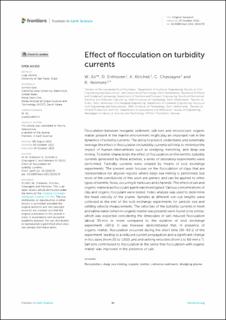| dc.contributor.author | Ali, W. | |
| dc.contributor.author | Enthoven, D. | |
| dc.contributor.author | Kirichek, A. | |
| dc.contributor.author | Chassagne, C. | |
| dc.contributor.author | Helmons, Rudolfus Lambertus Jacobus | |
| dc.date.accessioned | 2023-02-16T13:10:50Z | |
| dc.date.available | 2023-02-16T13:10:50Z | |
| dc.date.created | 2022-11-15T13:02:41Z | |
| dc.date.issued | 2022 | |
| dc.identifier.citation | Frontiers in Earth Science. 2022, 10 . | en_US |
| dc.identifier.issn | 2296-6463 | |
| dc.identifier.uri | https://hdl.handle.net/11250/3051542 | |
| dc.description.abstract | Flocculation between inorganic sediment, salt ions and microscopic organic matter present in the marine environment might play an important role in the dynamics of turbidity currents. The ability to predict, understand, and potentially leverage the effect of flocculation on turbidity currents will help to minimize the impact of human interventions such as dredging, trenching, and deep-sea mining. To better characterize the effect of flocculation on the benthic turbidity currents generated by these activities, a series of laboratory experiments were performed. Turbidity currents were created by means of lock exchange experiments. The present work focuses on the flocculation of clays that are representative for abyssal regions where deep-sea mining is performed, but most of the conclusions of this work are generic and can be applied to other types of benthic flows, occuring in harbours and channels. The effect of salt and organic material as flocculant agent was investigated. Various concentrations of clay and organic flocculant were tested. Video analysis was used to determine the head velocity of the plume. Samples at different run-out lengths were collected at the end of the lock exchange experiments for particle size and settling velocity measurements. The velocities of the turbidity currents in fresh and saline water (when no organic matter was present) were found to be similar, which was expected considering the timescales of salt-induced flocculation (about 30 min or more compared to the duration of lock exchange experiment <60 s). It was however demonstrated that, in presence of organic matter, flocculation occurred during the short time (30–60 s) of the experiment, leading to a reduced current propagation and a significant change in floc sizes (from 20 to 1,000 µm) and settling velocities (from 1 to 60 mm s−1). Salt ions contributed to flocculation in the sense that flocculation with organic matter was improved in the presence of salt. | en_US |
| dc.language.iso | eng | en_US |
| dc.publisher | Frontiers Media | en_US |
| dc.rights | Navngivelse 4.0 Internasjonal | * |
| dc.rights.uri | http://creativecommons.org/licenses/by/4.0/deed.no | * |
| dc.title | Effect of flocculation on turbidity currents | en_US |
| dc.title.alternative | Effect of flocculation on turbidity currents | en_US |
| dc.type | Peer reviewed | en_US |
| dc.type | Journal article | en_US |
| dc.description.version | publishedVersion | en_US |
| dc.source.volume | 10 | en_US |
| dc.source.journal | Frontiers in Earth Science | en_US |
| dc.identifier.doi | 10.3389/feart.2022.1014170 | |
| dc.identifier.cristin | 2074194 | |
| cristin.ispublished | true | |
| cristin.fulltext | original | |
| cristin.qualitycode | 1 | |

